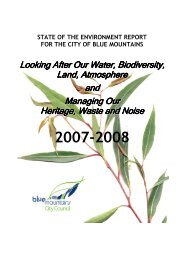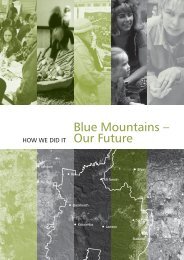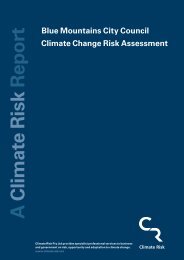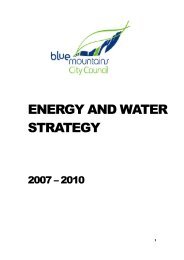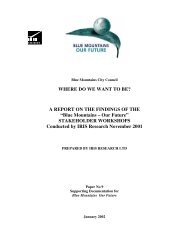State of the Environment Report for the City of Blue Mountains
State of the Environment Report for the City of Blue Mountains
State of the Environment Report for the City of Blue Mountains
Create successful ePaper yourself
Turn your PDF publications into a flip-book with our unique Google optimized e-Paper software.
Section 3: Atmosphere as a Natural Asset<br />
Our Atmosphere Resources<br />
Motor vehicles<br />
Greenhouse gas emissions from<br />
road transport in NSW have<br />
increased steadily over <strong>the</strong> last<br />
10 years because both vehicle<br />
numbers and <strong>the</strong>ir use are<br />
growing. As a result, overall<br />
vehicle emissions in 2000<br />
showed a 20.3 per cent<br />
increase on 1990 levels (NSW<br />
SoE 2003). Vehicle emissions<br />
also contribute to reduced local<br />
air quality due to particulate<br />
pollutants. The number <strong>of</strong><br />
<strong>Blue</strong> <strong>Mountains</strong> residents<br />
who journey to work by car<br />
increased by 24 per cent<br />
between 1991–2001.<br />
Commercial and<br />
industrial sources<br />
Under <strong>the</strong> Protection <strong>of</strong> <strong>the</strong><br />
<strong>Environment</strong> Operations Act<br />
1997, industries over a certain<br />
threshold must be licensed<br />
to pollute air or water. There<br />
are approximately 14 active<br />
<strong>Environment</strong> Protection<br />
Licences in <strong>the</strong> <strong>Blue</strong> <strong>Mountains</strong><br />
Local Government area, as<br />
issued by <strong>the</strong> NSW <strong>Environment</strong><br />
Protection Authority under <strong>the</strong><br />
Protection <strong>of</strong> <strong>the</strong> <strong>Environment</strong><br />
Operations Act 1997 (PoEO<br />
Act). Many <strong>of</strong> <strong>the</strong>se activities<br />
are licensed <strong>for</strong> emissions o<strong>the</strong>r<br />
than air. During <strong>the</strong> reporting<br />
period, <strong>the</strong> public made 3<br />
complaints to <strong>the</strong> EPA Pollution<br />
Line regarding air pollution<br />
incidents in <strong>the</strong> <strong>Blue</strong> <strong>Mountains</strong><br />
Local Government Area.<br />
Greenhouse gas emissions<br />
The increase in population<br />
in <strong>the</strong> <strong>Blue</strong> <strong>Mountains</strong> and<br />
general trends in increasing<br />
consumption per capita<br />
throughout NSW is likely to<br />
have increased <strong>the</strong> greenhouse<br />
gas emissions attributable to<br />
our community. Net emissions<br />
are likely to be increasing<br />
and <strong>the</strong> rate <strong>of</strong> increase may<br />
also be on <strong>the</strong> rise. Most <strong>of</strong><br />
<strong>the</strong> increases in Australia’s<br />
greenhouse gas emissions over<br />
<strong>the</strong> past decade have come<br />
from <strong>the</strong> generation and use<br />
<strong>of</strong> energy, agriculture, land-use<br />
changes and motor vehicles.<br />
Energy production and energy<br />
conversion (mainly coal-fired) is<br />
<strong>the</strong> main source <strong>of</strong> greenhouse<br />
gas emissions in NSW (AGO<br />
2002 cited in EPA 2003).<br />
What is <strong>the</strong><br />
current state <strong>of</strong><br />
<strong>the</strong> atmosphere<br />
in our region<br />
Globally, <strong>the</strong> current main<br />
issues with our atmosphere<br />
are depletion <strong>of</strong> <strong>the</strong> ozone<br />
layer, rapid enhancement <strong>of</strong> <strong>the</strong><br />
greenhouse effect resulting in<br />
climate change, and air quality<br />
– both ambient and indoor.<br />
These have impacts on plant<br />
growth and function, climate,<br />
agriculture, human and animal<br />
health and ecosystem function.<br />
The ozone layer<br />
Stratospheric ozone<br />
concentrations have generally<br />
stabilised since catastrophic<br />
falls in <strong>the</strong> 1990’s, due to <strong>the</strong><br />
effectiveness <strong>of</strong> <strong>the</strong> Montreal<br />
Convention and associated<br />
ef<strong>for</strong>ts to eliminate production<br />
and use <strong>of</strong> CFC’s and<br />
halocarbons.<br />
Enhancement <strong>of</strong> <strong>the</strong><br />
Greenhouse effect/<br />
Climate change<br />
The combustion <strong>of</strong> fossil fuels<br />
and clearing <strong>of</strong> <strong>for</strong>ests are<br />
increasing levels <strong>of</strong> greenhouse<br />
gases in <strong>the</strong> atmosphere.<br />
This has <strong>the</strong> effect <strong>of</strong> altering<br />
<strong>the</strong> overall heat balance and<br />
leading to changes in global<br />
climate and wea<strong>the</strong>r patterns.<br />
A continuing rise in greenhouse<br />
gas emissions is predicted to<br />
bring about global warming<br />
and an increase in extreme<br />
wea<strong>the</strong>r events, varying from<br />
region to region (IPCC, 2001).<br />
A recent modelling study<br />
undertaken by CSIRO,<br />
suggest that <strong>the</strong> climatic<br />
impacts predominant in<br />
eastern NSW, will be: extreme<br />
temperature and rainfall events<br />
resulting in droughts and<br />
bushfires, in addition to lack<br />
<strong>of</strong> water supplies <strong>for</strong> cities<br />
and <strong>the</strong> natural ecosystem<br />
(CSIRO, 2002).<br />
Climate change is discussed<br />
fur<strong>the</strong>r in Section 4.<br />
Australia’s total net greenhouse<br />
gas emissions increased by<br />
2.3 per cent over <strong>the</strong> period<br />
1990–2004 which is an<br />
additional 12.8 million tonnes<br />
<strong>of</strong> carbon dioxide equivalent<br />
(ABS, 2006). Although Australia<br />
has not ratified <strong>the</strong> Kyoto<br />
Protocol, this increase in<br />
CO 2<br />
(eq) emissions is just <strong>of</strong>f<br />
Australia’s target <strong>of</strong> a 2 per<br />
cent increase in emissions. The<br />
2 per cent net increase not only<br />
reflects <strong>the</strong> ef<strong>for</strong>ts to minimise<br />
emissions but is largely due<br />
to <strong>the</strong> halt to land clearing<br />
practises that occurred during<br />
this reporting period.<br />
Air quality<br />
There is no reliable data about<br />
air quality in <strong>the</strong> <strong>City</strong> <strong>of</strong> <strong>Blue</strong><br />
<strong>Mountains</strong>, as <strong>the</strong> <strong>City</strong> falls<br />
outside <strong>the</strong> Metropolitan Air<br />
Quality Study carried out by <strong>the</strong><br />
Department <strong>of</strong> <strong>Environment</strong><br />
and Conservation.<br />
We can infer, however, that air<br />
quality in <strong>the</strong> <strong>Blue</strong> <strong>Mountains</strong><br />
is likely to be better than in<br />
many areas <strong>of</strong> metropolitan<br />
Sydney. This is because <strong>the</strong><br />
area is elevated and lies<br />
beyond <strong>the</strong> Sydney airshed,<br />
has relatively low levels <strong>of</strong><br />
industry, has large natural<br />
areas which provide a buffer<br />
between <strong>the</strong> Sydney Basin<br />
and <strong>the</strong> Local Government<br />
Area and as a result <strong>of</strong><br />
frequent ‘flushing’ <strong>of</strong> air due<br />
to topographic-induced winds<br />
and breezes. Air pollutants and<br />
photochemical smog (seen as a<br />
brown haze) from <strong>the</strong> Sydney<br />
region are not thought to<br />
significantly affect air quality<br />
in <strong>the</strong> <strong>Blue</strong> <strong>Mountains</strong>.<br />
Indoor air quality can be poor<br />
even when outside air quality is<br />
very good, as it is determined<br />
primarily by indoor sources <strong>of</strong><br />
pollution in combination with<br />
poor building ventilation. Many<br />
people’s main exposure to air<br />
pollutants occurs when <strong>the</strong>y<br />
are indoors, such as at home,<br />
in <strong>the</strong> workplace or in<br />
entertainment venues (CSIRO<br />
2003). Main sources are indoor<br />
fires (heating, gas cooking,<br />
smoking) and <strong>the</strong> emissions<br />
from new products such as<br />
furniture made with glue,<br />
paints, plastics. Given <strong>the</strong><br />
presence <strong>of</strong> unflued gas<br />
heaters/cookers and solid<br />
fuel heaters (such as fires or<br />
combustion heaters) in <strong>the</strong><br />
mountains, and <strong>the</strong> cold<br />
wea<strong>the</strong>r which may encourage<br />
residents to reduce ventilation<br />
in <strong>the</strong> home, indoor air quality<br />
may be an issue. Smoking<br />
indoors is also a pressure on<br />
indoor air quality. Given <strong>the</strong><br />
high incidence <strong>of</strong> childhood<br />
asthma in some areas <strong>of</strong> <strong>the</strong><br />
mountains (a condition which<br />
can be exacerbated by poor<br />
indoor air quality), this issue<br />
probably warrants fur<strong>the</strong>r<br />
investigation.<br />
2005–2006 Supplementary <strong>State</strong> <strong>of</strong> <strong>the</strong> <strong>Environment</strong> <strong>Report</strong> <strong>for</strong> <strong>the</strong> <strong>City</strong> <strong>of</strong> <strong>Blue</strong> <strong>Mountains</strong> 25



